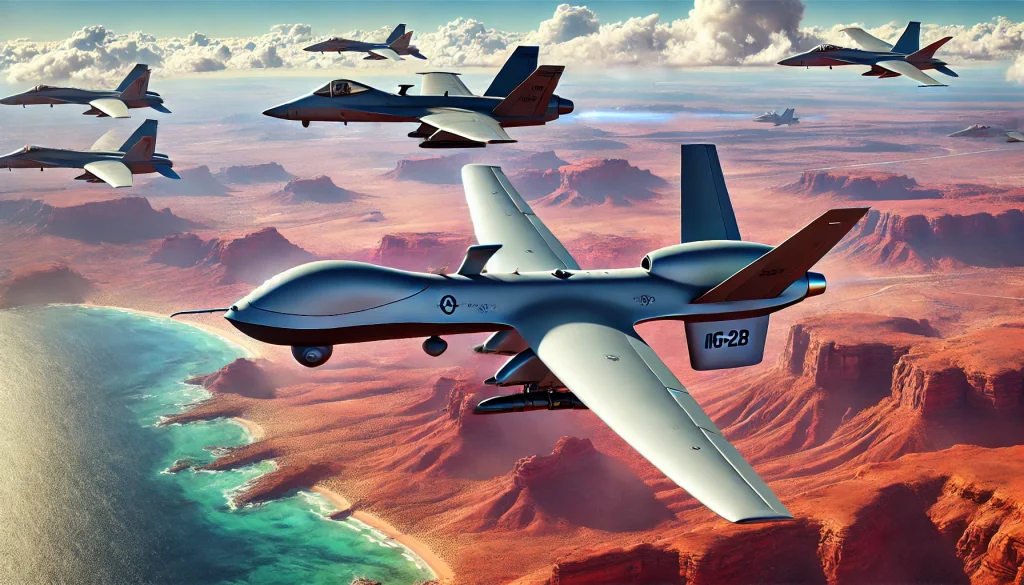Australia’s defence strategy is evolving, driven by a vast geography and the need for technologically advanced solutions that mitigate manpower constraints. Among emerging initiatives, the Ghost Bat program—a collaboration between Boeing and the Royal Australian Air Force (RAAF)—represents a significant leap into uncrewed combat platforms. Below, we examine how Australia’s move to autonomous defence is unfolding, the challenges faced by the Ghost Bat project, and what it all means for national security.
1. Australia’s Strategic Need for Uncrewed Combat Systems

1.1 Geographic Drivers
- Immense Territory: Covering 7.7 million square kilometers, Australia’s terrain demands broad surveillance and rapid response across coastal and remote regions.
- Maritime Focus: Long coastlines require persistent patrolling. Autonomous drones reduce the burden on manned aircraft, ensuring continuous oversight at a fraction of the cost.
Outcome: Uncrewed air systems can be force multipliers, allowing limited personnel to manage wide-range missions from centralized command hubs.
1.2 Addressing Manpower Constraints
- Recruitment & Training: Specialized pilots are expensive and time-consuming to train. Uncrewed platforms ease pilot load, letting skilled operators handle multiple drones.
- Endurance & Scale: Drones can remain airborne longer than many manned jets, offering constant coverage or deep strike options with reduced risk to human operators.
2. Spotlight on the Ghost Bat Program
2.1 Partnership with Boeing
- Local Manufacturing: The Ghost Bat (previously known as Boeing Airpower Teaming System or ATS) is designed partly in Australia. Some final assembly and flight testing happen in Queensland.
- Collaborative Development: Boeing’s Australian branch works closely with the RAAF, harnessing local aerospace talent and engineering expertise.
2.2 Capabilities & Vision
- Loyal Wingman Concept: Ghost Bat is envisioned as a “wingman” for manned fighters, providing reconnaissance, electronic warfare, or even armed support.
- AI & Autonomy: The platform relies on advanced sensor fusion and decision-making algorithms for semi-autonomous or fully autonomous missions.
- Scalable Fleet: Multiple Ghost Bats can coordinate missions collectively, expanding coverage or forming protective screens around manned aircraft.
Potential: Bolstering RAAF strike groups, the Ghost Bat can handle high-risk tasks—like SEAD (Suppression of Enemy Air Defences)—with minimal human risk.
3. Challenges Facing the Ghost Bat & Uncrewed Defence

3.1 Funding Fluctuations
- Budget Pressures: Defence budgets face competing demands—submarine modernization, air force modernization, and army expansions. The uncrewed program must secure consistent funding amidst broader strategic reviews.
- Cost-Overruns: Cutting-edge R&D can inflate costs, raising concerns about per-unit viability if volumes stay low.
Implication: Without stable budgets, bridging advanced drone prototypes to full operational fleets can stall, limiting the strategic impact of uncrewed systems.
3.2 Integration with Existing Fleet
- Manned-Unmanned Teaming: Operating Ghost Bat alongside Super Hornets or F-35s requires specialized communication links, data protocols, and mission planning synergy.
- Interoperability: Allies might question if Aussie drones seamlessly connect with US or allied systems in joint operations, forcing standardization efforts (NATO data links, common message protocols).
Technical Hurdle: Ensuring secure, jam-resistant connections, plus well-tested “Loyal Wingman” behaviors that don’t compromise safety in multi-jet formations.
3.3 AI Reliability & Ethics
- Autonomy Boundaries: Some missions may need fully autonomous capabilities—like deep strike or contested airspace infiltration. This raises ethical and command-and-control dilemmas.
- Decision-Making: If Ghost Bat must identify targets autonomously, policy guidelines on lethal autonomy must be clarified, reflecting Australia’s stance on AI in warfare.
4. National Security & Public Sentiment
4.1 Evolving Defence Posture
- Strategic Benefit: Uncrewed systems can deter adversaries or quickly respond to unexpected threats (e.g., maritime aggression, incursion of airspace).
- Flexible Deployments: Freed from human pilot limitations, drones can undertake tasks from intelligence gathering to targeted strikes with minimal risk to Australian personnel.
4.2 Public & International Perspectives
- Domestic Debate: Some local communities or peace groups voice concerns about the moral implications of unmanned strike capabilities. Others support the technology as a cost-effective defensive measure.
- Allied Partnerships: The US, UK, and other allies watch Australia’s uncrewed progress—lessons learned might shape future collaborations or co-development programs.
Conclusion: The general public’s acceptance or wariness can shape the pace of uncrewed adoption. Transparent policymaking and ethical frameworks remain key to maintaining trust.
5. Future Role of Uncrewed Platforms
5.1 Wider Drone Ecosystem
- Naval & Army: Similar autonomy expansions might appear in maritime drones (for anti-submarine warfare) or ground-based UGVs (unmanned ground vehicles) for reconnaissance.
- Commercial Spin-Offs: Tech breakthroughs from Boeing’s drones or Aussie aerospace R&D can spin into advanced cargo drones or emergency response bots.
5.2 Next Steps in Implementation
- Training & Doctrine: RAAF likely invests in specialized operator training, scenario-based mission planning, and robust simulation for loyal wingman tactics.
- Scaled Production: If Ghost Bat tests remain successful, scaling manufacturing to dozens (or hundreds) of airframes is plausible, ensuring real operational muscle.
Long-Term: This shift can reshape how Australia secures its airspace—fewer manned jets, more swarming or loyal wingman drones, an integrated approach bridging physical and cyber realms.
Conclusion
Australia’s vast geography and pressing defence needs push the Ghost Bat and other autonomous platforms to the forefront of future airpower. With Boeing collaboration and local aerospace expertise, uncrewed systems promise cost-effective force multiplication for the RAAF. Nevertheless, challenges around funding, integration, and ethical autonomy remain. If navigated successfully, the shift to autonomous defence could bolster Australia’s national security, reaffirm its commitment to cutting-edge technology, and shape a new era of air combat strategy—all while carefully addressing public sentiment and allied cooperation.










